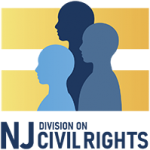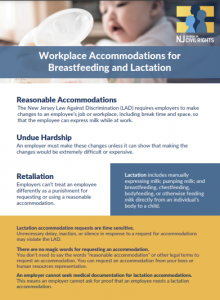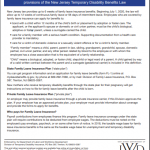Updated February 3, 2025
Many parents choose to or must return to work soon after their babies are born. With the availability of reliable breast pumps, it is possible to continue breastfeeding after returning to paid employment. New Jersey and federal laws protect an employee’s right to express breastmilk in the workplace. Please see information and downloadable fact sheets on the rights of a breastfeeding employee on our Legal Rights–Breastfeeding and Employment page.
Breastfeeding benefits to employers include:
- Babies have fewer illnesses, thus mothers take fewer sick days to care for sick infants;
- Fewer infant illnesses mean lower health care costs to the employer;
- Companies experience decreased employee turnover and higher employee morale because mothers are more likely to return to their previous employment when they know they can continue to breastfeed; and
- Appealing, family-friendly image for the business.
What you need to succeed at pumping breast milk at work:
- A reliable pump
- A private place to pump
- Break time during which to pump
- A place to store your milk (refrigerator, insulated carrier with cold packs, etc.)
Lactation resources for breastfeeding families
 Guidance on Workplace Accommodations for Pregnant, Postpartum, Breastfeeding, and Lactating Employees
Guidance on Workplace Accommodations for Pregnant, Postpartum, Breastfeeding, and Lactating Employees
The NJ Division on Civil Rights recently published new guidelines and an accompanying fact sheet regarding lactation rights for employees under the NJ Law Against Discrimination. These resources provide additional details about employees’ lactation protections that can be used to organize and advocate for NJEA members’ rights.
 For example, the fact sheet provides information about how often an employee may need to pump or express milk: “Lactation is often necessary every 2 to 3 hours and may take at least 15-20 minutes. In an 8-hour shift, an employee may need 2 to 3 breaks of at least 30 minutes to express and store milk” (page 2).
For example, the fact sheet provides information about how often an employee may need to pump or express milk: “Lactation is often necessary every 2 to 3 hours and may take at least 15-20 minutes. In an 8-hour shift, an employee may need 2 to 3 breaks of at least 30 minutes to express and store milk” (page 2).
 New Jersey Family Leave Insurance Program
New Jersey Family Leave Insurance Program
Following the birth of an infant, many New Jersey workers (both fathers and mothers) are eligible to obtain up to six weeks of paid family leave, in addition to disability leave already provided by their employer. This leave can provide wonderful additional time for bonding with baby and getting breastfeeding off to a great start.
Working and breastfeeding
Articles from La Leche League International on working and breastfeeding.
Workandpump.com
Working mom Kirsten Berggren’s website comprehensive website on what works when a breastfeeding mom returns to work.
New Jersey WIC Program
The NJ WIC program can provide breastfeeding assistance and support to low-income mothers who return to work in addition to providing healthy foods.
For employers: why lactation programs are important
Mrtek & Mrtek (1995). Supporting breastfeeding moms in the workplace helps the company’s “bottom line”. Here’s the proof: Study finds breastfeeding moms have one-third as much maternal absenteeism (one-day absences) to care for sick children in their first year of life as compared to formula feeding moms.
Cohen, R., Mrtek, M. B., & Mrtek, R. G. (1995). Comparison of maternal absenteeism and infant illness rates among breast-feeding and formula-feeding women in two corporations. American journal of health promotion : AJHP, 10(2), 148–153. https://doi.org/10.4278/0890-1171-10.2.148
http://www.ncbi.nlm.nih.gov/pubmed/10160049
Ball & Wright (1999). In the first year of life, after adjusting for confounders, there were 2033 excess office visits, 212 excess days of hospitalization, and 609 excess prescriptions for these three illnesses per 1000 never-breastfed infants compared with 1000 infants exclusively breastfed for at least 3 months. These additional health care services cost the managed care health system between $331 and $475 per never-breastfed infant during the first year of life.
Ball, T. M., & Wright, A. L. (1999). Health care costs of formula-feeding in the first year of life. Pediatrics, 103(4 Pt 2), 870–876.
Employers’ toolkits and assistance
Business Case for Breastfeeding
Extensive package of resources, information, assistance and tools for an employer to establish a lactation program.
Workplace Breastfeeding Support
Information and assistance from the US Breastfeeding Committee.
Centers for Disease Control
Promoting Worker Well-Being through Maternal and Child Health: Breastfeeding Accommodations in the Workplace

